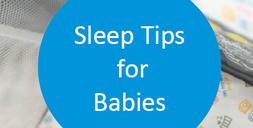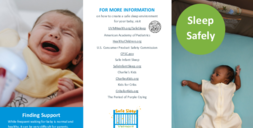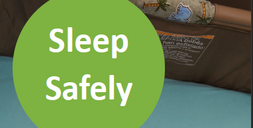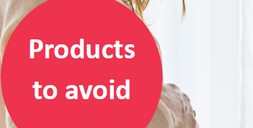Every year, around 3,500 babies in the United States die unexpectedly while sleeping. Most of these deaths are due to Sudden Unexpected Infant Deaths (SUID). SUID is a term used to describe infant deaths related to sudden infant death syndrome (SIDS), overlay, and accidental deaths from suffocation or strangulation.
A safe sleep environment can reduce the risk of SUIDs. A safe sleep environment for your baby is a sleep space without anything that could prevent their ability to breathe. By being aware of safe sleep tips and guidelines — like putting your baby to sleep on their back, in a safety-approved crib —everyone who cares for a baby will know the best ways to help their little ones sleep safe and sound.
Although it is tiring, all babies wake frequently because their sleep periods are shorter than adults, and they need to eat often. It is normal, natural, and good that newborn infants wake up often. Waking frequently at night is temporary, and as babies grow, they will sleep longer.
If you are an educator or provider looking for resources, please see the Resources for Educators and Providers page.
- Babies should always be placed on their back for sleep.
- Babies should sleep on a firm sleep surface that does not incline.
- Remove all toys, pillows, blankets, and bumpers from the crib.
- It’s OK to swaddle a baby, but stop swaddling as soon as they start learning to roll.
- If the baby falls asleep in a car seat, stroller, swing, or infant carrier, move them as soon as you can.
- It’s dangerous for babies to sleep on a couch, armchair or nursing pillow.
- Try giving your baby a pacifier at nap time and bedtime, after breastfeeding has been established.
- Keep the baby's bassinet or crib in your bedroom for at least the first 6 months.
- Reach out to your child’s doctor or your home visiting nurse if sleep is a problem for your family
For the full list of recommendations, see the American Academy of Pediatrics (AAP) safe sleep policy
Room sharing means keeping your baby's sleep area in the room where you sleep for at least the first 6 months. Place your baby's crib, bassinet, portable crib, or play yard near your bed. This will make it easier for you to feed and comfort your baby at night.
Bed sharing means having your baby sleep in the same bed as another child or adult. Bed-sharing raises a baby’s risk of injury or death. The risk is even higher if:
- The baby is younger than 4 months
- The surface is soft (a waterbed, old mattress, sofa, or armchair)
- A person in the bed took medications that make it harder to wake up
- Someone in the bed drank alcohol or used drugs that make it harder to wake up
- The baby was born early or with low birth weight
- A person in the bed is a smoker
- Someone in the bed is not the baby's parent
- Pillows or blankets are on the bed
Room sharing can decrease the risk of SUID by as much as 50% and is much safer than bed sharing.
| Resource | Description |
|---|---|
| AAP General Sleep Information | Find information from doctors on sleep for your baby- everything from making a safe sleep environments to soothing, swaddling, and the stages of infant sleep. |
| AAP Safe Sleep Guidelines | Guidelines, tips and resources for making a safe sleep environment. |
| Consumer Product Safety Commission | Learn about crib safety and check if specific products are ok for safe sleep. |
| Quit Line | Quitting smoking is healthier for both you and your child, and can reduce the risk of SIDS. Reach out for support in quitting. |






